Born in the Barrio:
The Cafe Bustelo Story
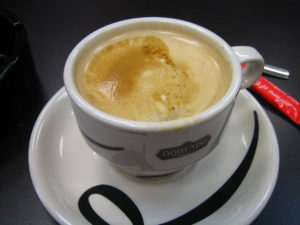
Cafe con leche, a favorite drink of Hispanics.
Long before the fascination with café latte, café con leche was in vogue. Café Bustelo, the strong, dark roast often used to make this milky espresso drink, first gained a following in Latin neighborhoods. Bustelo stalwarts often took it straight, topped with espumita, its signature foam. Along with a piece of toast, the refreshment made for a simple breakfast.
When I tried it, I found the coffee harsh and bitter, but I persevered. The flavor wasn’t really the point. There was something daring about partaking of a drink whose very name had an exotic ring. It sounded vaguely Latin or Spanish to me, but that was as far as my curiosity took me. Being conversant with Bustelo in post-college days made me feel grown up. This was no Chase and Sanborn or Chock Full o’Nuts.
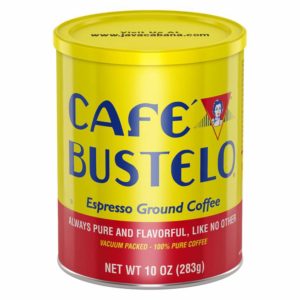
Cafe Bustelo in its familiar can.
The bright red and yellow colored Bustelo can was also alluring. I kept an empty container on my desk, a combination memento and pencil holder.
It was only recently that I felt driven to explore the history of my youthful enthusiasm. Knowing more about Bustelo might help me better understand myself and the times in which I grew up. I started unearthing its history.
The story of Bustelo is an immigrant tale. The saga is intertwined with the early Latin settlement of the Spanish Harlem neighborhood in New York City. The founder of the business, Gregorio Menendez Bustelo, was a Spanish transplant. Born in Spain’s Asturias region in 1894, he was an émigré who had also experienced life in the Latin Caribbean. Gregorio spent time in Cuba, where he discovered the joys of the land’s dark roast. He married a woman he met there and they migrated to another former Spanish colony, Puerto Rico. The U.S. Congress had just passed a new law, the Jones-Shafroth Act, which gave all Puerto Ricans American citizenship, and the adventurous couple took advantage of it. In 1917, Gregorio and Angelina moved to New York City and settled in East Harlem, which was gradually taking on a Spanish flavor. Migrants from Spain, Puerto Rico, and Latin American countries were supplanting the Italians, who, in turn, had replaced the Irish and Germans. (Today, the area has been attracting Mexican immigrants.)
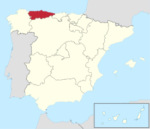
The Asturias region, on Spain’s northern coast.
Bustelo worked as a chef’s helper in the kitchen of the Hotel Pennsylvania, all the while nursing his dreams of opening his own business. One of his jobs, working as a traveling salesman, heightened his interest in the coffee trade. Customers snapped up the coffee he was hawking. The young couple soon bought a roaster with their small savings. Gregorio sold his product to neighborhood restaurants during the day and peddled it door-to-door at night.
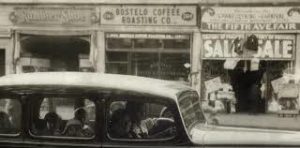
Storefront of Bustelo Coffee Roasting Co. on Fifth Avenue, NY
In 1931, he opened his own store on Fifth Avenue between 114th and 113th Streets. He called it the Bustelo Coffee Roasting Company. He joined other merchants, many of them also Spaniards, who were catering to the growing Latin population.
Bustelo’s shop was just one of many businesses in the enclave called “el barrio.” Across the street, Fifth Avenue Hardware, a store run by two friends from Spain’s Aragon province who married two sisters from Puerto Rico, made keys for newcomers. Nearby El Siglo, a gift shop, sold perfume, soap, and other niceties. The Valencia Bakery, another establishment across the avenue from the Roasting Company, lured customers with their trademark guava pastries and other delicacies. “Oldtimers still remember” this “pairing of Bustelo’s rich and dark espresso brew with the Valencia’s pastelillo de guayaba,” the “Traces of Spain in the U.S.” blog observed.
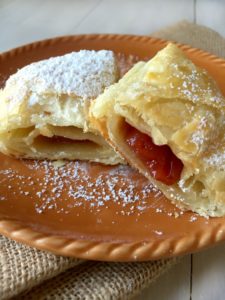
The popular pastry known as Pastelillo de guayaba
Bustelo, like many other business owners in East Harlem, had a special asset. He was conversant with the tastes of the Caribbean world. “Many enterprising Spanish-born immigrants—most of whom had spent time in Cuba or Puerto Rico—would establish businesses that would thrive, thanks in large measure to the patronage of the even larger and quickly expanding Puerto Rican population of the city,” James D. Fernandez, New York University professor and authority on Spanish immigration, points out.
An energetic arts scene also flourished in the quarter. Bustelo’s early business profited from the street trade drawn to the area’s exuberant music stories. The shops, which sold instruments, record players, sheet music, and radios, attracted musicians looking for jobs and band leaders seeking to hire performers. “Lamento borincano,” Puerto Rico’s unofficial national anthem, was written by Rafael Hernández, who, with his sister, Victoria, owned Almacenes Hernández, a neighborhood record store. Bustelo spread the word about his product by sponsoring radio and stage shows. His shop was also conveniently close to a popular movie theater. Attentive to the times films let out, he roasted his tantalizing coffee when showgoers were most likely to pass by.
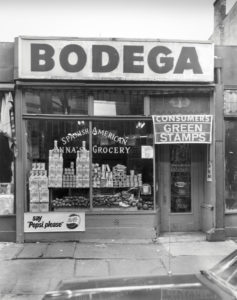
A bodega, a typical Latin corner store.
Bustelo sought out more outlets for his coffee. He signed up the city’s bodegas, the street corner convenience stores increasingly owned by Puerto Ricans. In New York City’s Hispanic neighborhoods and later in ethnic communities throughout the Northeast, the coffee’s fame spread. Bustelo became the coffee of choice in their households. The colorful Bustelo tin was a ubiquitous presence in Latin eateries. Bustelo was now a badge of identity.
Bustelo caught the eye of urban bohemians like myself, eager to embrace the exotic and the authentic. I soon lost track of the product that I had once found so captivating. Bustelo, I learned later, followed the familiar path taken by marginal enterprises that were discovered by the wider public. It attracted the interest of large corporations. Tetley, the global giant that started as a tea company, acquired Bustelo in 1963. J.M. Smucker now owns the brand.
The early storefront-turned-manufacturing-firm had been inching its way into the mass marketplace. The 1996 musical “Rent” assumed its audience was familiar with the brew (“Bustelo, Marlboro, banana by the bunch”). In HBO shows like “Girls,” set in Brooklyn, writer Rachel de Valle observes, the Bustelo can was a de rigeur prop, a cultural backdrop: “The red and yellow Café Bustelo tin is to the hipster kitchens what Heinz ketchup bottles are to American diners.”
Even as it cultivated millennials, Bustelo has struggled to maintain its ties to young Latin consumers. “Drinking coffee and dancing Salsa is part of our culture and tradition,” Jorge Gomez, a musician whose band the company promoted, told Ben Sisario of The New York Times. “You make it a party every day and for a Cuban party you need a little Bustelo coffee and a little rum.”
One of the company’s marketing ploys was selling café con leche in a can, a hit with music festival crowds. The product was called Bustelo Cool. I’ll take my Cuban coffee the old fashioned way, thanks.
Note: Professor James D. Fernandez’s writings on East Harlem and on Latin immigration generally were invaluable. Mine is a work in progress. If any readers know more useful details on Bustelo, please send them on to foodpassages@gmail.com.







